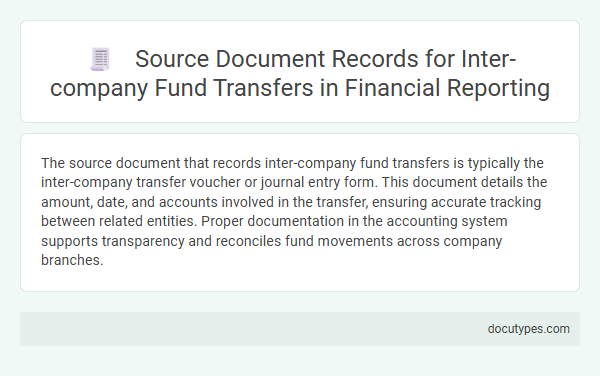The source document that records inter-company fund transfers is typically the inter-company transfer voucher or journal entry form. This document details the amount, date, and accounts involved in the transfer, ensuring accurate tracking between related entities. Proper documentation in the accounting system supports transparency and reconciles fund movements across company branches.
Introduction to Inter-company Fund Transfers
Inter-company fund transfers refer to the movement of funds between different entities within the same corporate group. These transactions ensure liquidity management and financial coordination across subsidiaries.
The primary source documents that record inter-company fund transfers include transfer vouchers, bank statements, and inter-company loan agreements. Transfer vouchers provide detailed authorization and documentation of the fund movement. Bank statements serve as external confirmations of the transfers, while loan agreements define the terms and conditions governing inter-company financing.
Importance of Source Document Records
| Source Document Name | Description | Role in Recording Inter-company Fund Transfers | Importance |
|---|---|---|---|
| Inter-company Transfer Voucher | A formal document authorizing the movement of funds between company subsidiaries or divisions. | Acts as the primary record authorizing and detailing the fund transfer. | Ensures transparency and formal approval, reducing the risk of errors or unauthorized transactions. |
| Bank Transfer Confirmation | Official confirmation from the bank verifying the transfer of funds. | Serves as proof that the transfer request was successfully executed by the financial institution. | Provides validation and audit trails necessary for financial reconciliation. |
| Internal Journal Entry | Accounting record reflecting the debit and credit of funds between entities within the company. | Records the accounting impact of the inter-company transfer in the ledger. | Facilitates accurate financial reporting and compliance with accounting standards. |
| Transfer Request Form | Document submitted to request approval for fund transfers between internal accounts. | Initiates the process and captures necessary details such as amount, date, and parties involved. | Maintains accountability and provides a clear audit trail of request and approval. |
| General Ledger Reports | Summary reports of all financial transactions including inter-company transfers. | Allows review and verification of transactions recorded in the source documents. | Supports thorough audits and ensures financial data integrity. |
| Source document records form the backbone of inter-company fund transfer transparency and accountability. Proper documentation protects your organization from financial discrepancies and supports compliance with regulatory and auditing requirements. Maintaining comprehensive and accurate source documents strengthens internal controls and enhances trust among stakeholders. | |||
Key Types of Source Documents
Source documents that record inter-company fund transfers are critical for maintaining accurate financial records across different entities within a corporation. Key types of these source documents include transfer vouchers, bank statements, and inter-company memos.
Transfer vouchers detail the authorization and amount of funds moved between entities, serving as primary evidence for the transaction. Bank statements provide verification of the transfer's completion, while inter-company memos explain the purpose and terms of the fund movement to support auditing processes.
Documentation Requirements for Inter-company Transfers
Source documents for inter-company fund transfers serve as essential records verifying the movement of funds between related entities within an organization. These documents include transfer requests, authorization forms, and bank statements ensuring accuracy and compliance.
Documentation requirements for inter-company transfers mandate clear identification of the involved entities, transfer amounts, dates, and purpose. Proper record-keeping supports audit trails, internal controls, and regulatory adherence in financial reporting.
Standard Procedures for Recording Transfers
Inter-company fund transfers require precise documentation to ensure accuracy and compliance with accounting standards. Standard procedures rely on specific source documents to record these transactions effectively.
- Transfer Request Form - This document authorizes the movement of funds between company entities, detailing the amount and purpose.
- Inter-company Payment Voucher - This voucher records the payment transaction, providing evidence of the transfer and approval.
- Bank Statement or Confirmation - Official bank records validate the completion of the fund transfer between accounts.
Audit Trail and Compliance Considerations
Source documents that record inter-company fund transfers include bank statements, transfer authorizations, and internal transfer logs. An accurate audit trail is essential to track the origin, approval, and completion of transactions, ensuring transparency and accountability in financial reporting. Your compliance with regulatory standards relies on maintaining these detailed records to support audit processes and prevent discrepancies.
Common Challenges in Source Document Management
Source documents for inter-company fund transfers typically include transfer authorization forms, bank statements, and internal ledger entries. Managing these documents poses several challenges that can affect accuracy and compliance.
- Document Integrity - Ensuring the authenticity and completeness of transfer records is crucial to prevent errors and fraud.
- Data Consistency - Discrepancies between source documents and recorded transactions often complicate reconciliation processes.
- Access Control - Restricting document access while maintaining availability for audit purposes remains a significant management hurdle.
Internal Controls for Source Document Integrity
Source documents for inter-company fund transfers typically include bank transfer confirmations, inter-company payment vouchers, and accounting journal entries. These documents are essential for verifying the authenticity and accuracy of each transaction between related entities. Implementing internal controls such as dual authorization, secure document storage, and regular audit trails ensures the integrity and reliability of these source documents.
Best Practices for Recordkeeping in Fund Transfers
Accurate source documents are crucial for recording inter-company fund transfers to ensure transparency and compliance with accounting standards. Best practices for recordkeeping enhance audit trails and support financial reconciliation across entities.
- Bank Transfer Records - Maintain detailed bank statements and transfer confirmations to validate the movement of funds between entities.
- Inter-company Agreements - Retain signed contracts or memos outlining the terms and approval of fund transfers to provide authorization evidence.
- Journal Entries - Document all accounting entries with clear references to the specific inter-company transaction to ensure proper ledger tracking.
Consistent and organized recordkeeping of these documents strengthens financial integrity and regulatory compliance in inter-company fund transfers.
What Source Document Records Inter-company Fund Transfers? Infographic

